Deck of the Week: Pauper UW Caw-Gates
- Connor Kirkwood
- Feb 1, 2023
- 5 min read
Updated: Aug 23, 2023
Where does the 'caw' come from?
Any deck with ‘Caw’ in its name is usually enough to send a shiver down the spine of any Magic player who played Standard in 2011. The infamous deck ‘Caw-Go,’ designed by the legendary Brian Kibler, which would eventually become ‘Caw-Blade,’ was one of the most powerful standard decks ever in rotation. The original deck, Caw-Go, was a control deck that included only four creatures total: Squadron Hawk. These four creatures were paired with Jace, the Mind Sculptor, as a shuffle effect for Jace’s Brainstorm effect. A player could Brainstorm with Jace and then use Squadron Hawk to shuffle the top two cards of the deck away, as well as get more Squadron Hawks so that the process could be repeated.
With the release of the Scars of Mirrodin block, Sword of Feast and Famine and Batterskull were introduced into Standard, and Stoneforge Mystic was quickly included in the deck, creating Caw-Blade. The strategy was to play a Stoneforge Mystic on turn two and eventually equip a Sword of Feast and Famine on a Squadron Hawk so that you could reset your lands each turn. The deck was so powerful that Jace and Stoneforge Mystic were quickly banned in Standard play, and eventually, they would also be banned in Modern for a time.
so what is caw-gates?
Since then, Caw-decks have not seen much play in any format, and Squadron Hawk’s name has fallen out of infamy. However, with the introduction of Commander Legends: Battle for Baldur’s Gate, that is about to change. The set introduced several powerful gates, the most important one being Basilisk Gate. It can give a creature +X/+X, where X is the number of gates you control. While these cards aren’t legal in Modern or Pioneer and are not powerful enough to touch Legacy or Vintage, one format happily accepts these cards; Pauper. All of the new gates are common rarity, so it was only a matter of time before someone found a way to break them in Pauper.
The gates have found their way into a new deck that revives the fears of Magic players from 2011; Caw-Gates. Interestingly enough, the core of the deck is very similar to Brian Kibler’s Caw-Go deck. The first obvious similarity is the inclusion of four Squadron Hawks, which are paired with Brainstorm in the deck to mimic the interaction of Jace and Squadron Hawk in Caw-Go. Caw-Gates relies on counterspells like spell pierce and counterspell and cards like Journey to Nowhere to keep your opponents from their own game plan, similar to Caw-Go.
The main difference between the two decks is the exclusion of planeswalkers in Pauper and the inclusion of the gates. Pauper doesn’t have powerful planeswalkers or equipment to win the game, so Caw-Gates relies on a more aggressive strategy to end the game. Alongside Squadron Hawk, Caw-Gates runs a playset of Sacred Cat, which at first glance seems relatively harmless. However, Squadron Hawk and Sacred Cat are very similar; they both are very cheap creatures that accrue value. Squadron Hawk is a 1/1 flier that gets you even more 1/1 fliers. Sacred Cat is a 1/1 lifelink creature that makes another 1/1 lifelink creature when it dies.
How do I play the deck?
Pairing these creatures with a Basilisk Gate is where the real power of the deck comes from. A Sacred Cat seems harmless until suddenly you are giving it +6/+6 with Basilisk Gate, and even if your opponent trades a bunch of creatures for it in combat, you can pay one white and get another for free. You can also play a Squadron Hawk and have a massive flier to kill your opponent, and even if your opponent kills the first one, you have three more to back it up.
These creatures are resilient, and the deck is built around protecting them. Not only is there a host of counterspells, but the deck also plays Prismatic Strands in the mainboard, which can protect your creatures from combat or removal spells, and can be flashed back easily to do it again. There are plenty of times that your opponent will forget that Prismatic Strands has flashback, and mistakes like this will usually push the game heavily in your favor. Caw-Gates also runs one of my favorite cards of all time; Coalition Honor Guard.
This card is tough to play around, as it survives against most burn spells, and it feels awful for your opponent to have to waste a kill spell just to kill this creature. This is similar to Prismatic Strands, as there are times when your opponent will completely forget it’s on the battlefield, or they will forget that the effect applies to any spell or ability they use. It feels especially nice to be at three life and have your opponent aim their last lightning bolt at you, only to wag your finger at them and point to the honor guard instead.
final thoughts
While this deck is powerful, it is not the most straightforward deck to play. There are a lot of choices that you have to make, such as land sequencing, when to hold up counterspells, when to be aggressive versus defensive, and card selection. The deck's primary goal is to have your opponents play your game instead of theirs. Perfectly utilizing card selection cards like Preordain, The Modern Age, and Brainstorm is essential. You really need to take your time, think about your plan for each game, and execute that plan.
Sometimes you must play the long game against control decks and wait until your opponent has exhausted their hand before you go for the kill. Sometimes you need to get out a Sacred Cat and just stem the bleeding from your burn opponent with its lifelink ability. Sometimes you need to get out a Squadron Hawk and hold off your opponent’s fairies. Having gates that enter tapped is also a tricky part of the deck, and you need to plan effectively so that you don’t end up with a tapped land on the turn when you really need the mana.
I recommend this deck to Magic players who love a challenge and finding different lines to victory. I would not recommend this deck if you are a Magic player who enjoys linear decks, like combo or burn. There are many choices with this deck, but at the same time, if you become a master with this deck, I believe you can be unstoppable. This has been a part of Magic since the printing of Alpha. If you want to pick up a deck and play it without any practice, then mono-red should do just fine. But if you want to truly understand a deck and become its master, I would pick up this deck immediately!

You can find the complete decklist here!





















Comments